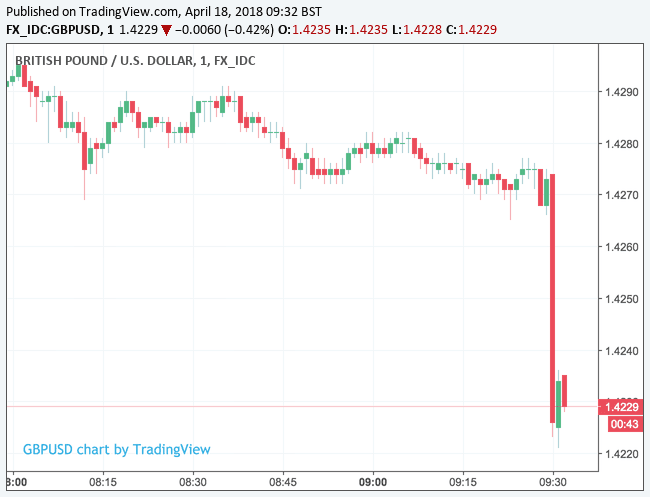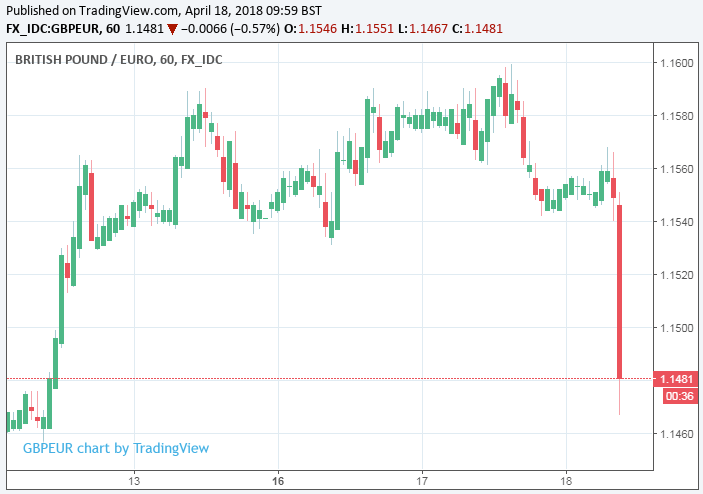Pound Sterling Slumps as UK Inflation Falls Faster than Expected
- Written by: James Skinner
-CPI drops to 2.5% and Core CPI falls to 2.3%, beneath BoE forecast.
-Surprise fall places a question mark over May interest rate rise.
-But this is good news for the consumer and broader UK economy.

© Andrey Armyagov, Adobe Stock
The Pound slumped broadly during the morning session Wednesday as markets responded to lower-than-expected UK inflation figures for March, which place a question mark over the probability of another interest rate rise at the Bank of England next month.
Headline inflation fell to 2.5% during the recent month when markets had expected it to hold steady at the same 2.7% seen in February. This is far beneath the Bank of England forecast for inflation of 2.8% in the first quarter.
Core inflation, which removes volatile food and energy items from the goods basket and so is seen as a more reliable measure of domestically generated inflation pressures, also posted a surprise fall when it dropped from 2.5% to 2.3%.
The Office for National Statistics attributes much of the fall to a lesser rise in the prices of clothing and footwear on the high street however, prices of alcohol and tobacco also made a contribution to the fall in the headline measure.
UK core goods inflation falling right on cue, pushing CPI inflation down to just 2.5% in March, well below the MPC's 2.8% forecast. Markets have concluded far too hastily that a May rate hike is a done deal pic.twitter.com/CwyAblvv7E
— Samuel Tombs (@samueltombs) April 18, 2018
Markets care about inflation because it has implications for interest rates, which are themselves typically a predmoninant driver of exchange rates because of the influence that rising and falling returns can have on international capital and speculative money. After all, it is inflation that central banks are attempting to manipulate when they tinker with interest rates.
"The fall-back in inflation in March probably won’t prevent the MPC from hiking interest rates next month, although it perhaps makes it slightly less likely," says Paul Hollingsworth, senior UK economist at Capital Economics. "The Committee is more focussed on domestic cost pressures, and yesterday’s labour market figures revealed a pick-up in regular (ex bonuses) pay growth."
Judging by the market reaction, Wednesday's numbers may now have placed a question mark over what was a solid consensus that the Bank of England would raise interest rates at its next meeting in May. Perhaps more importantly question marks are now being placed over further interest rate rises.
"The BoE now has a tough decision to make. Against a global backdrop of higher rates, domestic data is turning over. Sterling is much lower on expectations of the dots pushing out from May this year," says Neil Jones, head of corporates and financial institutions at Mizuho Bank.

Above: Pound-to-Dollar rate shown at 15 minute intervals.
The Pound-to-Dollar exchange rate is quoted 0.58% lower at 1.4208 following the releases, after extending an earlier 0.13% loss, the Pound-to-Euro exchange rate was also marked down 0.58% at 1.1487.

Above: Pound-to-Euro rate shown at hourly intervals.
Wednesday's data comes closely on the heels of February wage growth and labour market data that showed average household earnings growing in "real terms" for the first time in a year, while the unemployment rate also fell to a new 42 year low of 4.2%.
The data also comes just weeks ahead of the May interest rate decision from the Bank of England that was widely expected to yield another 25 basis point increase in the Bank Rate, which would take the UK's main interest rate at 0.75%.
"The inflation data is unlikely to stop the MPC from hiking next month, but the decline in trend inflation is likely to keep the MPC on hold for the rest of the year," says Kathrin Goretzki, an FX strategist with UniCredit Bank in London. "We think any dissent on the MPC at the May meeting would imply upside risks for EUR-GBP back towards the sideways range seen since end-September 2017."
This suggests the Pound-to-Euro exchange rate could well slip back below the 1.15 level and into the 1.11-1.15 range that Goretzki is highlighting. However, and on a brighter note, weaker than expected inflation numbers could pay dividends to the economy further down the line.
The UK consumer has been under pressure since the EU referendum after a sharp fall in the Pound raised the cost of imports and pushed inflation higher. This has hampered "real GDP" and ushered in a return to negative wage growth for the labour force. Now, with inflation falling the squeeze on real GDP and household finances is coming to an end.
Look for this knee-jerk move lower in $GBP and gilt yields to be short-lived. A bit of an overreaction to one data release. Expect $GBPUSD to drift back into 1.42-1.43 range, though risks of $EURGBP breaching 0.86 have been shelved for now
— Viraj Patel (@VPatelFX) April 18, 2018
"In any case, the fact that inflation has fallen further means that real wages are likely to have strengthened more than expected, relieving some of the pressure on consumers which may make it easier for the MPC to raise interest rates further," says Hollingsworth.
Hollingsworth also says that for every incremental fall in UK inflation, the consumer will receive a boost to their purchasing power and the economy an automatic dividend.
This is because much of the slowdown in UK GDP, which is reported after taking inflation into account, has been the result of the sharp post-referendum rise in the consumer price index. UK inflation rose from 0.5% in June 2016 to a peak of 3.1% in November 2017 as a direct result of the double-digit devaluation of Pound Sterling that followed the referendum.
However, with Sterling in recovery mode and inflation on the slide then, assuming economic activity remains at broadly constant levels, the UK's "real GDP" numbers should receive a dividend later in the year. This may encourage the Bank of England to continue raising interest rates regardless of short term movements in inflation.
"Overall, though, coming on top of some weaker activity data recently, today’s inflation figures are likely to make a rate hike in May a close run thing. But we still think that it is more likely than not," Hollingsworth adds.
Bank of England to Raise Rates in May
Anticipation of a rate hike has mounted after the BoE warned in February that it could raise rates further and faster than markets were gave it credit for if the UK inflation picture evolved in line with its most recent forecasts.
Rate setters predicted at the time that inflation would remain above the 2% target until at least the first quarter of 2021 and that it would average around 2.8% for the first quarter of 2018. Since then, inflation has fallen faster than forecast, down from 3% to 2.5%, but the outlook for wage growth has firmed.
It is not yet clear whether the steeper than expected fall in consumer prices will be enough to encourag the BoE to "wait and see" for a few more months before raising rates again, or if it will be minded to go ahead with a rate rise out of concern over the faster pace of wage growth.
What is clear however, is that a failure to raise rates in May will be bad for Pound Sterling because markets are betting heavily that the BoE will pull the trigger and push ahead with what will be only its second hike since the financial crisis.
Pricing in interest rate derivatives markets, which enable investors to protect themselves against changes in interest rates and also provide insight into expectations for monetary policy, implies a May 10 Bank Rate of 0.648%.
This suggests a greater than 50% probability the BoE will go ahead next month. Any change for the worse in this implied probability would hit the Pound hard.;
Equally, but on the opposite side of the same coin, if the Bank of England were to go ahead with an interest rate rise and signal to markets that it is likely to follow up with another hike before the year is out, then this could provide Pound Sterling with a powerful leg-up into the summer months.
At 1.1559, the currency remains 13% lower against the Euro than it was before the Brexit referendum while the Pound-to-Dollar rate is only a fractio below the level it was at before the result became known.
Advertisement
Get up to 5% more foreign exchange by using a specialist provider to get closer to the real market rate and avoid the gaping spreads charged by your bank when providing currency. Learn more here.




